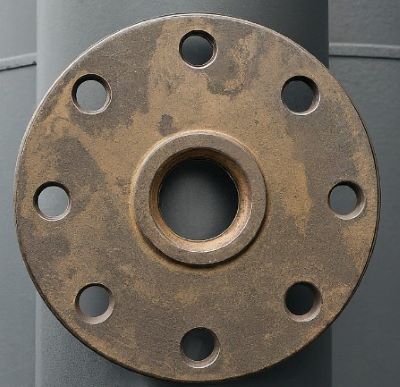Imagine this: you’re responsible for a critical industrial pipeline system. Everything is running smoothly, until disaster strikes. A stray forklift damages a flange, causing a leak that shuts down operations for hours, costing your company thousands of dollars.
Sounds like a nightmare? It doesn’t have to be. The secret weapon in your arsenal: flange covers.
Flanges are what you need for your piping systems, connecting sections of pipe and ensuring a leak-proof seal. But like any exposed component, they’re vulnerable to damage and contamination. That’s where flange covers come in, acting as shields that protect your pipes from a multitude of threats.
The Problems Flange Covers Solve
Think of flange covers as tiny suits of armor for your pipes. They combat two major enemies:
Physical damage:
Ouch! A misplaced tool, falling object, or even harsh weather can leave unsightly dents, cracks, or even complete flange failure. Flange covers act as a buffer, absorbing the impact and keeping your pipes safe.
➡️ Sun’s out, flanges out… not! Exposure to UV rays and extreme temperatures can weaken flanges over time. Flange covers provide a protective layer, shielding them from the elements and extending their lifespan.
➡️ Travel blues? During transport or storage, exposed flanges are prone to snags, tears, and accidental damage. Flange covers secure them like seatbelts, ensuring they arrive at their destination unscathed.
Contamination:
➡️ Dirt happens. Wind, dust, and debris can easily find their way into exposed flanges, compromising the integrity of your system. Flange covers act as gatekeepers, keeping out unwanted guests.
➡️ Spills and leaks? Not on our watch! Chemical spills or leaks can have disastrous consequences. Flange covers contain them within the system, preventing contamination and protecting your entire operation.
➡️ Corrosion creeps in. Constant exposure to moisture or harmful elements can lead to rust and corrosion, weakening your flanges. Flange covers create a barrier, keeping them safe from these silent attackers.
The Benefits of Using Flange Covers
The advantages of using flange covers go far beyond just preventing problems. They’re an investment in:
➡️ Saving money: By preventing costly repairs, replacements, and downtime, flange covers pay for themselves in the long run.
➡️ Ensuring safety: Leaks and contamination can pose serious safety risks. Flange covers keep your system secure and your workers safe.
➡️ Meeting regulations: Many industries have strict regulations regarding flange protection. Flange covers ensure you’re compliant and avoid potential fines.
➡️ Extending lifespan: Protecting your flanges from wear and tear means they’ll last longer, saving you money on replacements.
➡️ Boosting efficiency: Fewer maintenance issues and disruptions mean your system runs smoothly, maximizing productivity.
Different Types of Flange Covers and Their Applications
Not all flanges are created equal, and neither are flange covers. Here’s a breakdown of the different types and their ideal uses:
Material:
➡️ Steel: Strong and durable for high-pressure applications.
➡️ Plastic: Lightweight and cost-effective for general protection.
➡️ Rubber: Flexible and resistant to chemicals and corrosion.
➡️ Composite: Combines the benefits of different materials for specific needs.
Design:
➡️ Blind covers: Simple and secure for complete flange closure.
➡️ Full-face protectors: Encompass the entire flange for maximum protection.
➡️ Banded covers: Wrap around the flange for easy installation and removal.
Applications:
➡️ Industrial: From power plants to refineries, flange covers safeguard critical systems.
➡️ Construction: Protect exposed flanges during construction and storage.
➡️ Marine: Withstand the harsh saltwater environment and prevent corrosion.
➡️ Food processing: Maintain hygiene and prevent contamination in food production.
➡️ Pharmaceutical: Ensure product purity and comply with strict regulations.
Do you want to know more about flanges? Explore these resources ⬇️⬇️⬇️
Butt Weld Flange: Unveiling The Diversity In Flange Types
Unveiling Strength: Square Flange Vs. Round Flange Connections
Forged To Last: The Strength Of Cast Iron Flanges
Choosing the Right Flange Cover for Your Needs
With so many options, choosing the right flange cover can seem daunting. But fear not! Consider these factors:
➡️ Size: Ensure the cover matches your specific flange diameter.
➡️ Pressure rating: Choose a cover that can withstand the system’s pressure.
➡️ Temperature range: Select a material suitable for the operating temperatures.
➡️ Environment: Consider factors like weather, chemicals, and UV exposure.
➡️ Material compatibility: Ensure the cover material won’t react with your pipes or fluids.
Conclusion: Safeguard Your System, Invest in Flange Protection
Flange covers might seem like a small detail, but their impact is undeniable. They are the silent guardians of your piping systems. They stand as a barrier against physical damage, contamination, and corrosion. They prevent costly repairs, downtime, and safety hazards.
Don’t wait for disaster to strike. Invest in the long-term health and efficiency of your system by choosing the right flange covers for your needs. With a variety of materials, designs, and applications available, there’s a perfect fit for every flange.
Post time: Apr-10-2024


